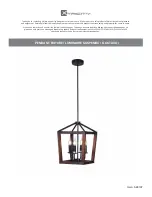
2-19
CRANE CAPACITY CHART, DEFINITIONS, AND RULES
:
The load radius is the horizontal distance from the centerline of boom rotation (the center of
the turntable when it is level), to the vertical load line with the load suspended. Because of
deflections of the boom and carrier, the load radius increases when a load is hoisted from its
resting place. The load radius may be measured with a measuring tape. If the desired load
radius falls between two load radii on the chart, use the load radius with the lower capacity.
Interpolating between the numbers is not recommended.
Load capacity ratings on this equipment are given on the basis that operations are to be
conducted on firm and level terrain and in a safe environment. A level sensor and a screen
on the
Dash Display
have been provided to aid the operator in leveling the crane. These
capacity ratings are to be reduced in proportion to any deviation from the prescribed
conditions. Any unfavorable environmental condition, such as soft, sloping or uneven terrain,
high wind, or hazardous surroundings constitutes a deviation.
The main boom capacities are given in relation to the load radius at which the load is being
handled. Boom extension capacities depend on the boom angle, the boom extension angle,
and load radius. The capacities shown on the capacity chart are the maximum allowable at
the indicated radius. The greatest load that may be handled by the BMC RT-400 is 40,000
pounds (18100 kg), but only at an 8
-
foot (2.4 m) radius, on outriggers. All load ratings,
operating radii, work areas, boom extension offsets, and outrigger conditions are shown on
the capacity chart. A laminated chart is attached near the operator's seat as well as in the
literature compartment. An electronic version of the chart may also be accessed through the
Dash Display.
These charts are for the express purpose of informing the operator when a
load can or cannot be safely handled.
The capacities shown in the 360° ROTATION and ON RUBBER 360° columns of the
capacity chart apply to the entire 36
0°
rotation of the boom. The capacities are
maximum allowable at the indicated radius. The capacities ON OUTRIGGERS OVER
FRONT and ON RUBBER FRONT are limited to the work area sectors shown on the chart.
Note that the ON RUBBER 360° capacities are much less than the ON RUBBER FRONT
capacities. The least stable position of the boom is over the sides of the crane. Use great
care when swinging a load from the front or rear of the crane toward the sides of the crane.
The load must be known in order to assure that the crane will not tip.
N O T I C E
Under certain load conditions, torsion
induced in the chassis can cause it to
twist. This may result in an opposite-side outrigger or tire lifting free from the
supporting surface. This is most likely to occur when the boom is positioned
over one corner of the machine. The condition does not indicate a loss of
stability when working within the limits of the capacity chart. Provided the
crane capacity has not been exceeded, operation may continue without
restriction.
Summary of Contents for RT-400-A
Page 6: ......
Page 7: ...1 3 RT 400 A TURNING DIMENSIONS...
Page 14: ......
Page 34: ...2 20...
Page 35: ...2 21...
Page 36: ...2 22...
Page 56: ...3 9 RT 400 A LUBRICATION CHART...
Page 57: ...3 10 RT 400 A LUBRICATION CHART...
Page 58: ...3 11 RT 400 A LUBRICATION CHART...
Page 74: ......
Page 86: ...3 39 BOOM CHAIN ADJUSTMENT...
Page 92: ......
Page 93: ......
















































